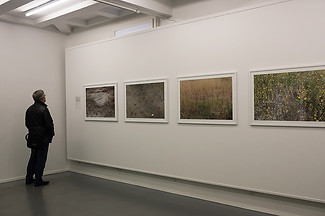This is a landscape where the terrain shapes around sites of industrial and old toxic activity. The subtle scars of human presence – vegetation as it follows disruptions to the land — reveal unplanned ecological diversity. At these sites, nature resides in spite of human intervention. The representation of landscape, questions of land use, and underlying environmental concerns are intertwined issues explored in this work.
The act of traveling this landscape is central to my process. I seek transitional and feral sites that sit parallel to evidence of human activity. The act of walking with feet firmly on the ground, is a meditation on and within these spaces. I return to places over and over, as a way to sense and witness the rhythms of change. Moving through this landscape is an immersive experience where simultaneous beauty and destruction are woven together in a complicated tapestry.
Drawing upon the historic photographs of the 19th century Westward Expansion tradition, I allude to landscapes that present an open sense of promise. However, in contrast, I am interested in portraying a tightly layered depiction; one that plays with perceptions of space, and presents a complex relationship with our surroundings.
Unlike romantic notions of preservation which serve to uphold an illusion of human domination over nature, these landscapes express the sometimes contradictory and sometimes symbiotic relationship that humans and the natural environment maintain.
These sites that lie at transitional edges of our ecological and cultural space, lay bare the effects of our 21st century condition. These are places where resilient life resides in quiet disregard of human presence and defines its own terms — bending along human lines of activity, but maintaining its quiet hold.
Statement

